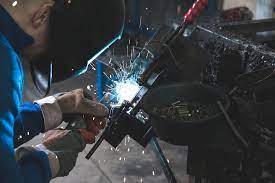Metalworking refers to the procedure of forming metals into final products. The industry has innovative methods and techniques to cut, shape and join the metal. It is important to note that metalworking has been around for centuries. Ancient cultures such as the Egyptians and Mayans have implemented metals into objects, which served different purposes.
Throughout history, metals have been considered a building material, religious symbolism, and status symbols. Some ancient metalworking techniques are still implemented today.
As humanity has evolved, the implementation of metals is gaining huge importance. From vehicles to electronics, metals are crucial for technology improvements. You can find out more about metalworking here https://levstal.com/blog/metal-works-101/.
Learning metalworking
The learning process depends on the scope of work you are interested in, the projects you want to work on, the resources, and more. If you’re going to work in metalworking, you will need to practice a lot. Also, you need to learn about safety when using different types of equipment.
However, the effort will pay off. Your metalworking skills can open the doors to various industries, including jobs as a blacksmith, machinist, goldsmith, jeweler, founder, and lots of other options. The jobs connected with metalworking come with a decent salary, attracting many individuals to this industry. However, the salary will depend on various factors such as experience, the type of work, and location.
Metalworking implementation
The techniques get a comprehensive implementation, ranging from decorative uses to building structures. The methods will remain similar when working with different types of metals. However, the characteristics of the chosen metal will determine the final result.
Casting
Casting includes pouring melted metal to a particular mold to create a specific shape. The mold can be made of sand, plaster, or stone. The finished result is a solid metal object.
Casting is a widely used method thanks to its cost efficiency, aligning the production of the same pieces quickly. Sand casting uses sand as a mold to form a solid object, which is cost-efficient. Die casting is an automated process where the machine injects the melted metal into a mould under high pressure.

Cutting
Metalworking includes sophisticated cutting methods for building the final product. The metal can be cut with tools or advanced machines, depending on the project. Metal cutting can be completed with a few different methods. In addition, we share the various techniques available.
Milling
Milling is a method used for producing pieces with excellent precision and accuracy.
Turning
Turning refers to the process of moving the workpiece while the tool cuts through it linearly.
Grinding
Grinding is a price where the materials get removed from a metal piece using abrasive surfaces. The result is a clean-cut and a fine finish.
Drilling
Drilling is the process of making holes in the metal so that you can join them together with water with the use of bolts.
Joining
The process consists of joining two pieces of metal together. Welding is the most commonly used method, including a welding machine to join the metals. However, this method is used for large projects. If you have a small joining project, you will use a soldering device.
Forming
This method includes shaping the metal as it is, without any further additions. Forming consists of applying heat or pressure or a hybrid approach to form the metal in the desired condition.
Forging is one of the standard methods that includes heating the metal and using a hammer to curve it to the preferred form. Rolling is the method of creating thin pieces of metal.






